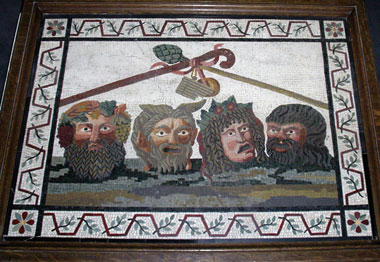 |
 |
 Roman Mosaic ca. 1st - 4th century AD Museum Collection, 55.83 Mosaic is a form of decoration that uses small pieces of colored stone, glass, or other materials to create a pattern or picture. Mosaics were popular throughout the ancient world as a domestic interior decoration, and were common in Roman dwellings during the period of the Roman Empire. They are also commonly found intact in ruins and Roman constructions. Often built into the floor, a mosaic’s design could demonstrate a variety of scenes, including historical events or portraiture of gods and famous figures. It was typically placed in the main room of the house where guests would see it and comment about it - a mosaic was meant to be studied and discussed. Some mosaics had standard designs, while wealthy villa owners could afford a more personalized mosaic. The Everhart Museum’s Roman floor mosaic was probably created for a private villa. From left to right, the mosaic depicts the gods Dionysus, Pan, Apollo and Helios, whose traditions began with ancient Greek mythology and were adopted by the Romans. Dionysus (Latin, Bacchus), the god of wine, is depicted wearing a crown of vine leaves and grapes, representing wine. Above him is his thyrsus, a wand tipped with a pine cone, an ancient fertility symbol. Next is Pan (Latin, Faunus), seen here with a goat-like face, pointed ears, and horns. The god of the woods, fields, flocks, and herds, he is often called Universal Pan, the Greek word pan meaning “all”, and he pervading all things. Pan was also a god of fertility, and was attributed as inventing the syrinx or pan flute, on which ten or more reed pipes are arranged in a row of ascending length. Apollo, one of the twelve gods of Olympus, was the embodiment of the classical Greek spirit, standing for the rational and civilized side of human nature. Apollo had many attributes indicating the variety of his functions: as patron of poetry, music and the Muses, he is crowned with laurel leaves, awarded for achievement in the arts; as guardian of the flocks, he is often shown with a shepherd’s crook. Apollo was also known as Phoebus (Radiant) Apollo, and identified with the sun god Helios (Latin, Sol), whose cult was widespread under the Roman Empire. Helios rode his golden chariot through the circular golden band, represented by the zodiac belt. This region of the heavens well known to the ancients as the path through which the sun was observed to pass annually. His attributes are the whip and the globe. |











